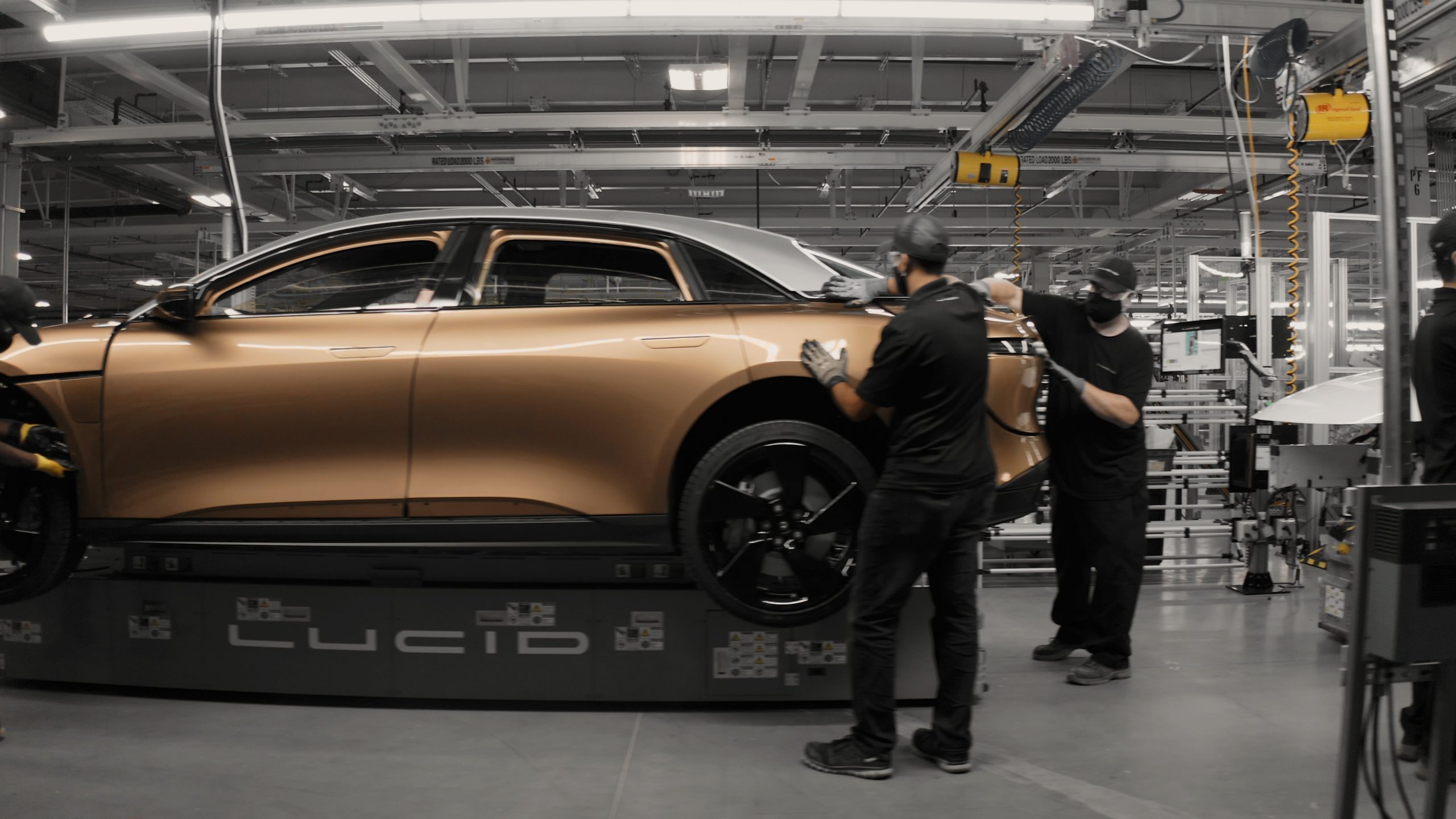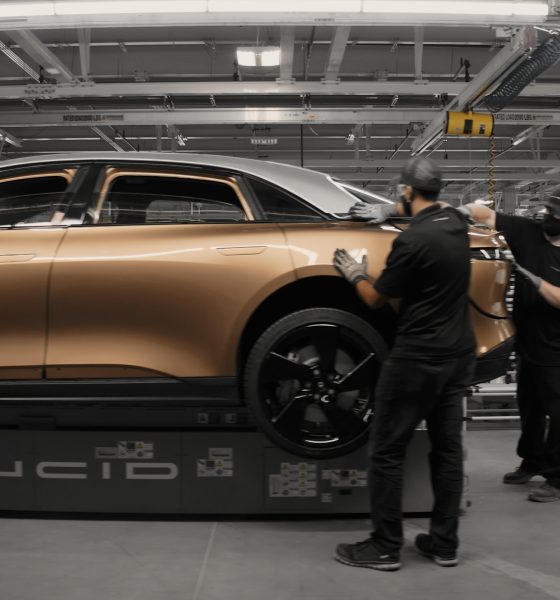

News
Lucid Motors details production efforts, new showrooms, and its SUV
Lucid Motors has released new details regarding the production of the Air sedan, along with plans of an upcoming flagship studio in New York City and some minor updates on the Gravity SUV that it announced late last year.
Lucid and Churchill Capital Corp IV filed new details with the SEC, stating that the company has completed the “preproduction builds and has started the production of quality validation builds of the Lucid Air.” Automakers utilize preproduction builds to identify problems or issues before the model goes on sale and is delivered to the public. Oftentimes, companies use this process to iron out production issues that won’t necessarily affect the vehicle’s performance. Still, more often than not, the cosmetic issues are what is being identified. Things like panel gaps or paint issues can be identified and resolved, so they are ready for the car’s production version.
Lucid shows the tedious process of building the Air Dream Edition
Along with the imminent production of what will eventually be delivery-ready models of the Air, Lucid also announced that capital and financial flexibility available upon the business combination with CCIV would enable the automaker to accelerate around $350 million of planned CAPEX investment from 2021 to 2023. These investments could expand by up to 6-7% from 2021 to 2026. The investments could be used for:
- Accelerate additional manufacturing capacity for the Lucid Air to capitalize on expected demand, and implement a dedicated Lucid Gravity general assembly line
- Combines the next two phases of the Arizona facility expansion into one expedited phase
- Provides 2.7 million square feet of additional manufacturing space by 2023, enabling increased Lucid Air capacity up to approximately 53,000 vehicles per year
- Improves production flexibility between Lucid Air and Lucid Gravity, as well as for specific vehicle variants.
- Enhance Lucid Gravity design/performance
- Vertically integrate certain functions (e.g., Stamping & Battery Enclosures) via accretive in-housing investments (higher quality/lower costs)
- The company expects to launch Lucid Gravity at the end of its projected second half of 2023 timeline and intends to have increased production of Lucid Air in 2023 and 2024. It expects total vehicle volumes to be unchanged for 2023 and 2024.
- Lucid continues to expect existing cash resources following the business combination will fund its planned operations at least through 2022.
Teslarati reported in March that Lucid received approval to expand its Casa Grande, Arizona, factory by 2,400,000 square feet. The new addition would include a Body in White expansion, Stamping Plant, General Assembly Lines, Powertrain Plants, Warehousing, and others.
Lucid said it recently passed 10,000 paid reservations for the Air sedan. These figures include the roughly 500 units that the automaker left for its premier variant of the car, the Dream Edition, along with the Grand Touring, Touring, and Pure variants. Lucid told Teslarati that the company would produce roughly 500 Dream Edition sedans. It closed reservations for the top variant on March 22nd.
Lucid also announced that it would open up a new “flagship” Studio in the Meatpacking District of New York City this week. Earlier this month, Lucid opened up a studio in Chicago, which has been operational since June 11th.
“The updates from Lucid Motors today reinforce the strong interest and demand from consumers for electric vehicles that deliver new industry standards for efficiency and range, which has actually allowed us to accelerate and enhance our plans for development and production,” Peter Rawlinson, CEO and CTO of Lucid, said. “The company is choosing to accelerate plant capacity expansions and to build a dedicated Lucid Gravity general assembly line which is expected to lead to higher Lucid Air sales volumes in 2023 while remaining within the second half 2023 Lucid Gravity launch window.”

Elon Musk
Elon Musk and Tesla AI Director share insights after empty driver seat Robotaxi rides
The executives’ unoccupied tests hint at the rapid progress of Tesla’s unsupervised Robotaxi efforts.

Tesla CEO Elon Musk and AI Director Ashok Elluswamy celebrated Christmas Eve by sharing personal experiences with Robotaxi vehicles that had no safety monitor or occupant in the driver’s seat. Musk described the system’s “perfect driving” around Austin, while Elluswamy posted video from the back seat, calling it “an amazing experience.”
The executives’ unoccupied tests hint at the rapid progress of Tesla’s unsupervised Robotaxi efforts.
Elon and Ashok’s firsthand Robotaxi insights
Prior to Musk and the Tesla AI Director’s posts, sightings of unmanned Teslas navigating public roads were widely shared on social media. One such vehicle was spotted in Austin, Texas, which Elon Musk acknowleged by stating that “Testing is underway with no occupants in the car.”
Based on his Christmas Eve post, Musk seemed to have tested an unmanned Tesla himself. “A Tesla with no safety monitor in the car and me sitting in the passenger seat took me all around Austin on Sunday with perfect driving,” Musk wrote in his post.
Elluswamy responded with a 2-minute video showing himself in the rear of an unmanned Tesla. The video featured the vehicle’s empty front seats, as well as its smooth handling through real-world traffic. He captioned his video with the words, “It’s an amazing experience!”
Towards Unsupervised operations
During an xAI Hackathon earlier this month, Elon Musk mentioned that Tesla owed be removing Safety Monitors from its Robotaxis in Austin in just three weeks. “Unsupervised is pretty much solved at this point. So there will be Tesla Robotaxis operating in Austin with no one in them. Not even anyone in the passenger seat in about three weeks,” he said. Musk echoed similar estimates at the 2025 Annual Shareholder Meeting and the Q3 2025 earnings call.
Considering the insights that were posted Musk and Elluswamy, it does appear that Tesla is working hard towards operating its Robotaxis with no safety monitors. This is quite impressive considering that the service was launched just earlier this year.
Elon Musk
Starlink passes 9 million active customers just weeks after hitting 8 million
The milestone highlights the accelerating growth of Starlink, which has now been adding over 20,000 new users per day.

SpaceX’s Starlink satellite internet service has continued its rapid global expansion, surpassing 9 million active customers just weeks after crossing the 8 million mark.
The milestone highlights the accelerating growth of Starlink, which has now been adding over 20,000 new users per day.
9 million customers
In a post on X, SpaceX stated that Starlink now serves over 9 million active users across 155 countries, territories, and markets. The company reached 8 million customers in early November, meaning it added roughly 1 million subscribers in under seven weeks, or about 21,275 new users on average per day.
“Starlink is connecting more than 9M active customers with high-speed internet across 155 countries, territories, and many other markets,” Starlink wrote in a post on its official X account. SpaceX President Gwynne Shotwell also celebrated the milestone on X. “A huge thank you to all of our customers and congrats to the Starlink team for such an incredible product,” she wrote.
That growth rate reflects both rising demand for broadband in underserved regions and Starlink’s expanding satellite constellation, which now includes more than 9,000 low-Earth-orbit satellites designed to deliver high-speed, low-latency internet worldwide.
Starlink’s momentum
Starlink’s momentum has been building up. SpaceX reported 4.6 million Starlink customers in December 2024, followed by 7 million by August 2025, and 8 million customers in November. Independent data also suggests Starlink usage is rising sharply, with Cloudflare reporting that global web traffic from Starlink users more than doubled in 2025, as noted in an Insider report.
Starlink’s momentum is increasingly tied to SpaceX’s broader financial outlook. Elon Musk has said the satellite network is “by far” the company’s largest revenue driver, and reports suggest SpaceX may be positioning itself for an initial public offering as soon as next year, with valuations estimated as high as $1.5 trillion. Musk has also suggested in the past that Starlink could have its own IPO in the future.
News
NVIDIA Director of Robotics: Tesla FSD v14 is the first AI to pass the “Physical Turing Test”
After testing FSD v14, Fan stated that his experience with FSD felt magical at first, but it soon started to feel like a routine.

NVIDIA Director of Robotics Jim Fan has praised Tesla’s Full Self-Driving (Supervised) v14 as the first AI to pass what he described as a “Physical Turing Test.”
After testing FSD v14, Fan stated that his experience with FSD felt magical at first, but it soon started to feel like a routine. And just like smartphones today, removing it now would “actively hurt.”
Jim Fan’s hands-on FSD v14 impressions
Fan, a leading researcher in embodied AI who is currently solving Physical AI at NVIDIA and spearheading the company’s Project GR00T initiative, noted that he actually was late to the Tesla game. He was, however, one of the first to try out FSD v14.
“I was very late to own a Tesla but among the earliest to try out FSD v14. It’s perhaps the first time I experience an AI that passes the Physical Turing Test: after a long day at work, you press a button, lay back, and couldn’t tell if a neural net or a human drove you home,” Fan wrote in a post on X.
Fan added: “Despite knowing exactly how robot learning works, I still find it magical watching the steering wheel turn by itself. First it feels surreal, next it becomes routine. Then, like the smartphone, taking it away actively hurts. This is how humanity gets rewired and glued to god-like technologies.”
The Physical Turing Test
The original Turing Test was conceived by Alan Turing in 1950, and it was aimed at determining if a machine could exhibit behavior that is equivalent to or indistinguishable from a human. By focusing on text-based conversations, the original Turing Test set a high bar for natural language processing and machine learning.
This test has been passed by today’s large language models. However, the capability to converse in a humanlike manner is a completely different challenge from performing real-world problem-solving or physical interactions. Thus, Fan introduced the Physical Turing Test, which challenges AI systems to demonstrate intelligence through physical actions.
Based on Fan’s comments, Tesla has demonstrated these intelligent physical actions with FSD v14. Elon Musk agreed with the NVIDIA executive, stating in a post on X that with FSD v14, “you can sense the sentience maturing.” Musk also praised Tesla AI, calling it the best “real-world AI” today.








